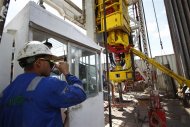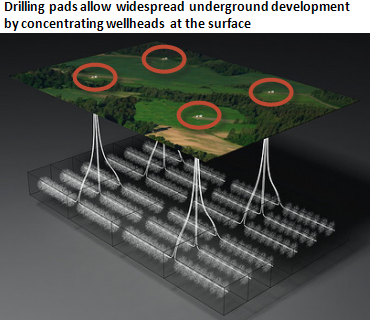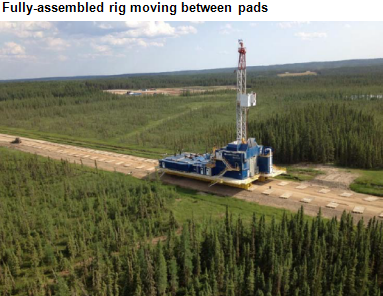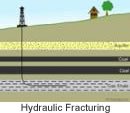Recycling is a good thing, right? This word has been around for quite a while now. People understand it and consider it a good thing. We are familiar with the "recycling" of aluminum cans, glass and plastic bottles, newspapers and plastic bags. In fact many of us have been dutifully separating these items from our trash and putting them out for waste pickup on a regular basis for years. Most of us make nothing from doing this, and even though it requires a bit of effort and forethought, we have learned to do it "for the good of the environment". It makes sense. These materials can be re-used and turned into other useful products and by doing so reduce the burden on our landfill waste disposal sites. It is a "win-win" situation for those modern motivators and business planners.
So why not recycle the water used in the "fracking" or hydraulic fracturing of rocks containing oil and gas? (See the many other articles in this blog explaining the hydraulic fracturing process.) Often when a well is drilled and used to produce oil and gas it also produces a lot of "formation water". This is water that has been trapped in these underground rocks for thousands, millions, tens and even hundreds of millions of years. Why not re-use this water to fracture rocks and produce more oil and gas? After all, the concern over water usage and "pollution" is used as the primary motivator by the so-called "environmentalists" so actively opposed to fracking. Recycling makes sense, so why is it not more widely embraced and practiced?
The reason why opponents of fracking won't admit it can be done safely and without destroying our precious freshwater sources, is because the opponents of fracking don't really care that much about water. They have other motives. Dig into an article. Read farther than the headlines, which are always emotionally charged, and usually written from a politically liberal viewpoint. In this case here is a quote from the following article:
"The practice scales down the amount of freshwater used for fracking, but environmentalists say it does nothing to assuage concerns about groundwater contamination, and only facilitates the extraction of fossil fuels that produce climate-warming gases."
So there it is, the real underlying motivation of "banning fracking" is to stop or limit the production of fossil fuels and the alleged link to "climate warming gases". So the concern about safe drinking water is an emotional ploy. Clean water is something everyone needs and desires. It is a clever trick, and in my opinion, evil, because it deprives people all around the world of something else everyone needs and wants: inexpensive energy. We cannot all ride bicycles and walk wherever we want to go. Nobody likes being deceived, and I see it going on all around. The only solution to this intentional misinformation is education. So here we are.
Another poorly understood benefit for using formation water, or re-used water in the fracking process is the water is usually in "equilibrium" with the rocks that are being fracked. After all, the water has been sitting there in the pore spaces of the rocks to be fracked for a long time. It has time to come to chemical equilibrium. Pumping it back underground during the fracking process does nothing to harm that balance.
There are more benefits to recycling. It saves money, tens and sometimes hundreds of thousands of dollars on the cost of drilling and completing a well. It reduces the cost and damage caused by the need of trucks hauling water. It reduces the cost of disposing of waste water. The water used comes from the deep oil and gas producing rock formations, thus it is by definition and usage, "polluted". So why not use it, and put it back where it came from and leave our much shallower drinking and irrigating water alone. This is truly a win-win situation, something everyone can be happy with.
Oil and gas companies and their service companies, like Baker Hughs and Halliburton, and Schlumberger, have been drilling and completing wells in similar ways for decades. They are very, very competitive with one another. Read the remainder of the article below. Why is this recycling not publicized and done more? Think government regulation. Think government politically motivated interference. Think environmental groups lobbying (bribing) politicians. Think big businesses promoting "alternative" energy like solar and wind, (which are fine in certain circumstances). Think corruption, like Solyndra. Think of ignorance. Think of those making and seeking to make Billions of dollars on "carbon taxes" and "carbon credits". Think Al Gore, and others acting as parasites on the public. Who suffers? You and I, us, the public, in the form of higher energy prices, which increase the cost of everything.
What do you say we fight back against the darkness and danger or ignorance. Spread the word.
Peter
By Nichola Groom
LOS ANGELES (Reuters) - The oil and gas industry is finding that less is more in the push to recycle water used in hydraulic fracturing. Slightly dirty water, it seems, does just as good a job as crystal clear when it comes to making an oil or gas well work.
Exploration and production companies are under pressure to reduce the amount of freshwater used in dry areas like Texas and to cut the high costs of hauling millions of barrels of water to oil and gas wells and later to underground disposal wells.
To attack those problems, oilfield service companies like Halliburton, Baker Hughes and FTS International, are treating water from "fracked" wells just enough so that it can be used again. Smaller companies like Ecosphere Technologies Inc have also deployed similar methods.
"It is a paradigm shift," Halliburton's strategic business manager of water solutions, Walter Dale, said.
Until recently, many companies considered recycling too expensive or worried that using anything other than freshwater would reduce well output.
But oil and gas companies are increasingly treating and reusing flowback water from wells, which unlike freshwater is very high in salt, with good results.
The practice scales down the amount of freshwater used for fracking, but environmentalists say it does nothing to assuage concerns about groundwater contamination, and only facilitates the extraction of fossil fuels that produce climate-warming gases.
"It doesn't lessen the potential for groundwater contamination, and it can increase the amount of contaminants that you are exposing the groundwater to," said Myron Arnowitt, Pennsylvania director for Clean Water Action.
Read the remainder or the article here:
http://finance.yahoo.com/news/analysis-fracking-waters-dirty-little-165146500.html
By Nichola Groom
LOS ANGELES (Reuters) - The oil and gas industry is finding that less is more in the push to recycle water used in hydraulic fracturing. Slightly dirty water, it seems, does just as good a job as crystal clear when it comes to making an oil or gas well work.Exploration and production companies are under pressure to reduce the amount of freshwater used in dry areas like Texas and to cut the high costs of hauling millions of barrels of water to oil and gas wells and later to underground disposal wells.
To attack those problems, oilfield service companies like Halliburton, Baker Hughes and FTS International, are treating water from "fracked" wells just enough so that it can be used again. Smaller companies like Ecosphere Technologies Inc have also deployed similar methods.
"It is a paradigm shift," Halliburton's strategic business manager of water solutions, Walter Dale, said.
Until recently, many companies considered recycling too expensive or worried that using anything other than freshwater would reduce well output.
But oil and gas companies are increasingly treating and reusing flowback water from wells, which unlike freshwater is very high in salt, with good results.
The practice scales down the amount of freshwater used for fracking, but environmentalists say it does nothing to assuage concerns about groundwater contamination, and only facilitates the extraction of fossil fuels that produce climate-warming gases.
"It doesn't lessen the potential for groundwater contamination, and it can increase the amount of contaminants that you are exposing the groundwater to," said Myron Arnowitt, Pennsylvania director for Clean Water Action.
Read the remainder or the article here:
http://finance.yahoo.com/news/analysis-fracking-waters-dirty-little-165146500.html













